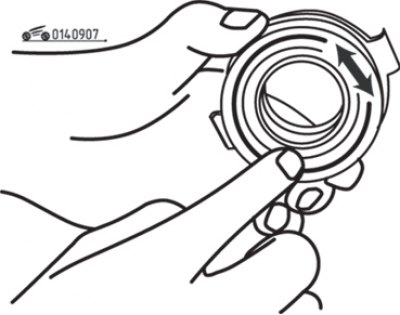Removing
Remove the gearbox.
Mark the position of the pressure plate on the flywheel so that it can be set to its original position during reassembly.
Use a special alignment tool or the handle of a screwdriver to support the clutch disc while removing the pressure plate.
Using a special tool or a screwdriver, use the teeth of the flywheel ring gear to block it from turning.
Gradually loosen the clutch assembly mounting bolts diagonally by turning each bolt half a turn until the spring action stops and the bolts can be unscrewed by hand.

Pic. 9.4. Location of clutch elements: 1 - gearbox; 2 - clutch cover with pressure plate; 3 – a conducted disk of coupling; 4 - flywheel; 5 - clutch release bearing
Remove the pressure plate while supporting the driven plate so that it does not fall out (pic. 9.4).
Handle the clutch disc carefully, being careful not to touch the lining surfaces, and set it aside.

Pic. 9.5. Removing the clutch release bearing
Disconnect the return spring from the clutch release fork hook, turn the release lever and remove the clutch release bearing (pic. 9.5).
Remove the clutch fork mounting bolt and remove the fork and lever assembly.
Visual check
Use an electric vacuum cleaner or a clean cloth to remove dust from the clutch cover. Do not use compressed air as asbestos dust is harmful to health when inhaled.
Inspect the pressure plate for signs of damage and wear to the diaphragm spring, scratches, nicks, or discoloration (indicates overheating) surfaces, check that there are no signs of damage or deformation of the casing. Slight defects in the friction surface can be removed with fine sandpaper, but the pressure plate must be replaced with a new one in case of any doubt about its condition.
Inspect the surface of the flywheel for uneven contact with the clutch disc, indicating improper installation or damage to the clutch diaphragm spring. Check the surface for burns, gouges, cracks or other signs of wear. If necessary, remove the flywheel and machine it to resurface. The surface of the flywheel can be polished with fine-grained sandpaper.

Pic. 9.6. Measuring the wear of the friction linings of the clutch disc
Inspect the friction linings of the clutch disc for contamination with oil, grease or any other substance and replace the clutch disc if necessary. Check the driven disk for wear by measuring the distance from the rivet head to the lining surface. Replace the disc if the wear of the friction linings has reached the limit shown in fig. 9.6.
Inspect the clutch disc for deformation, wear, loose rivets and springs, damage to the hub splines. Temporarily install the clutch disc onto the transmission input shaft and check for a smooth fit, no nicks or wear on the splines. If there is any doubt about the condition of the clutch disc, replace it.

Pic. 9.7. Check of smoothness of rotation of the bearing of deenergizing of coupling

Pic. 9.8. Checking the sliding of the clutch release bearing on the input shaft of the gearbox
Check the clutch release bearing for wear and make sure it rotates smoothly without abnormal noise and slides easily on the gearbox input shaft (pic. 9.7, 9.8). Except in cases of very low mileage, it is recommended that the bearing be replaced with a new one every time the clutch is removed.
Inspect clutch cover, release lever and return spring for wear, cracks, distortion, damage and metal fatigue, replacing as necessary.

Pic. 9.9. Checking the smoothness of rotation of the needle bearing at the end of the crankshaft

Pic. 9.10. Using an inertial puller to remove a needle bearing
Check the needle bearing at the end of the crankshaft to make sure it spins easily and smoothly with just your finger (pic. 9.9). If necessary, replace the bearing by removing it with an inertial puller and installing a new one in the crankshaft hole using a mandrel or a piece of tube of the appropriate diameter and a hammer (pic. 9.10). Lubricate the new bearing before installation and observe the reference distance shown in fig. 9.11.
Installation
When installing a new driven disc or clutch pressure plate, remove the anti-corrosion protection from them.
When installing the driven disc, make sure that even a small amount of oil does not get on its friction linings. Therefore, before installation, wipe the mating surface of the flywheel and the surface of the pressure plate with a clean rag, install the driven disk with clean hands.
Lubricate the clutch release bearing, input shaft splines and clutch disc splines with Moly paste lubricant before installation. Be careful not to get lubricant on the friction surface of the clutch disc, flywheel and pressure plate.
Hold the clutch disc with a special centering tool or a round rod, install the clutch assembly, aligning the holes in the clutch housing with the flywheel guide pins. When reinstalling a previously removed clutch pressure plate, check that the marks made before removal are aligned.
Tighten the clutch mounting bolts so that the clutch disc is pressed, but at the same time can still move to the sides.
Using a special drift or an old transmission input shaft, center the clutch disc on the flywheel.
Attention! If the clutch disc is not centered, it will not be possible to install the gearbox.
After centering the driven disc, gradually tighten the clutch cover mounting bolts diagonally to the required torque.
Remove the mandrel from the driven disk.
Install the clutch release lever, release fork, spring and release bearing.
